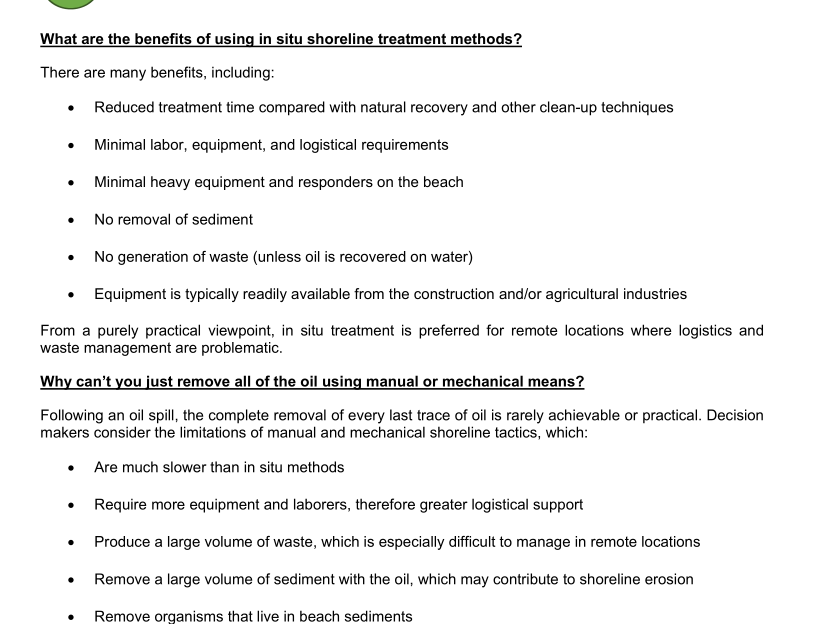API TR 1155-2 pdf download

API TR 1155-2 pdf download Shoreline In Situ Treatment (Sediment Mixing and Relocation) Fact Sheet
Mixing: Doesn’t the oil just become buried?
Burial of oil can be prevented by limiting the depth of mixing, which can be controlled by the choice andconfiguration of equipment.1″% In addition, buried oil can be brought to the surface by mixing tactics.
Sediment relocation—Doesn’t the oil just sink?
Relocation breaks up oiled sediments,which enhances the formation of OPA, and thereby facilitates thephysical removal and natural dispersion by wave and water action.
. Oil Particle Aggregates(OPAs) do not sink provided that both the oil and the fine particles are less
dense than the water.
. Breaking waves on even low energy shorelines and river currents keep the OPA emulsions in
suspension.
. When the oil is broken up into smaller particles by wave energy andlor OPA formation, dispersion
and biodegradation are accelerated ” , and therefore natural removal and weathering is enhanced..Monitoring during experimental field studies has shown that oil typically does not accumulate in
benthic sediments following sediment relocation18
Sediment relocation—-Aren’t you just pushing the oil from the beach intolonto the water?
Past spills and studies document that oiled sediments relocated into the water have a short persistence asthey are physically broken up, dispersed and biodegraded. 19
When the oil is broken up into smaller particles by wave energy and/or OPA formation, dispersionand biodegradation are accelerated, and therefore natural removal and weathering are enhanced. Inaddition, the relocation of oil from a dry to a wet environment results in increased concentrations ofbacteria and nutrients, which further accelerates biodegradation.
Due to these accelerated processes,aquatic toxicity is minimized.Monitoring conducted duringexperimental field trials in Norway confirmed that sediment relocation did not elevate toxicity in thenearshore environment to_unacceptable levels,nor did it result in consequential alongshore ornearshore sediment oilinq.20
In past cases and studies, oil or sheen on the water has rarely been observed, but even whenobserved,this was minimal and non-persistent, as the oilsheen rapidly evaporated,dispersed,and/or formed OPA_21
lf brown foam is observed adjacent to the relocated sediments, this is a positive indication that theaggregation/OPA process is actively taking place.This foam typically remains for only a few minutes,but may be deposited as a very thin line at the swash.
. ln some cases, containment and recovery equipment (booms, sorbents,skimmers,vacuums) may be used to collect anticipated released oil.
Sediment relocation: Doesn’t the oil just wash back up onto the beach?
Relocated sediment can be distributed back up the beach over a few tidal cycles; however, this is after the oilhas been liberated from the sediment and the oil forms OPA in suspension.
Some undispersed oil or brown foam may be deposited along the swash line. In such cases,sediment relocation may be repeated one or more times. On the Bouchard 155 operation,somesegments required only one relocation pass,whereas others required wo or three before oilresidues were no longer observed.”
Sorbent materials can be used to collect any free-floating oil or foam both on the water and on thebeach; however,past spills and studies have confirmed that little or no residual oil has stranded onthe treated or adjacent shorelines following sediment relocation.
Sediment relocation: Doesn’t it contribute to shoreline erosion?
Sediment relocation does not remove sediment from the beach,unlike manual and mechanical removaltechniques, and therefore reduces the potential for shoreline erosion due to treatment.
Relocated sediment can be distributed back up the beach over a few tidal cycles. 21
Sediment relocation is conducted with consideration of local tides and currents,for example,treatment can be conducted on a rising tide,so that sediment can be quickly and directlyredistributed back up the beach.
. On shorelines with significant longshore drift, the sediment can be relocated updrift to ensure that the
sediment returns naturally to the area from which the sediment was removed.
. Pre- and post-treatment beach profile surveys help to monitor the recovery of the profile of the
beach.
How do these methods impact shoreline wildlife?
Shoreline in situ methods can minimize potential effects on wildlife due to treatment, because they requireless heavy equipment, are faster, and more effective in removing the oil than other treatment methods.
.A benefit of in situ tactics is that the treatment is rapid,and therefore,with respect to flora andfauna, the oil exposure time and extent are quickly reduced.
. There may be some short-term localized disturbance of shore sediments,exposure of oiled
sediments, and/or small releases of oil/sheen/foam. Such disturbances can be mitigated by planningthe treatment to ensure that vegetated areas and lower intertidal zones are avoided, timing thetreatment to avoid important migration andor nesting seasons, and/or using wildlife deterrents, suchas scare cannons or visual methods during the physical treatment.









